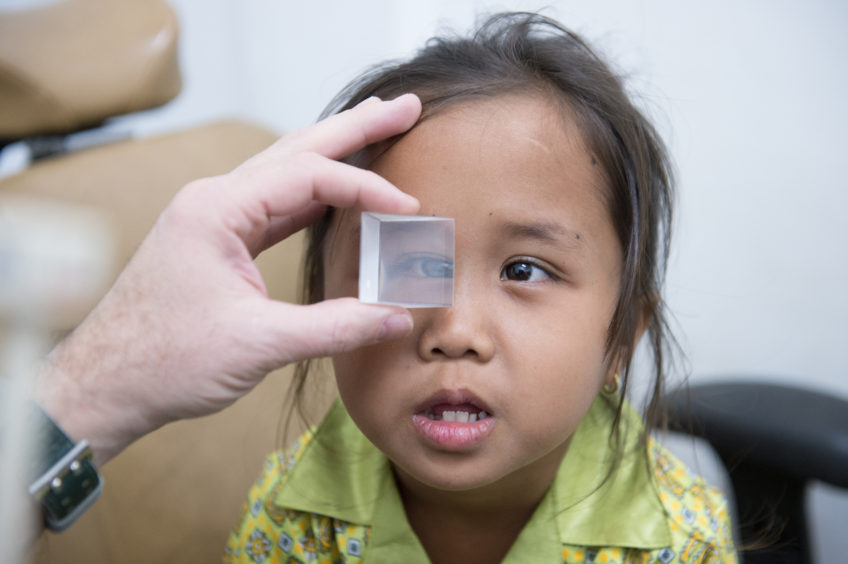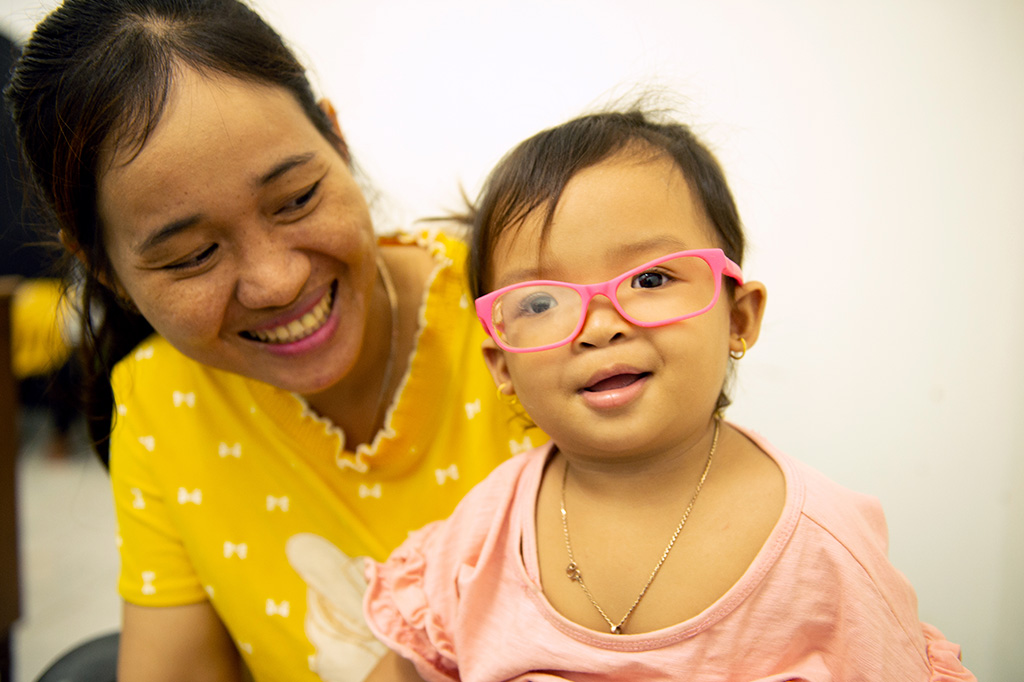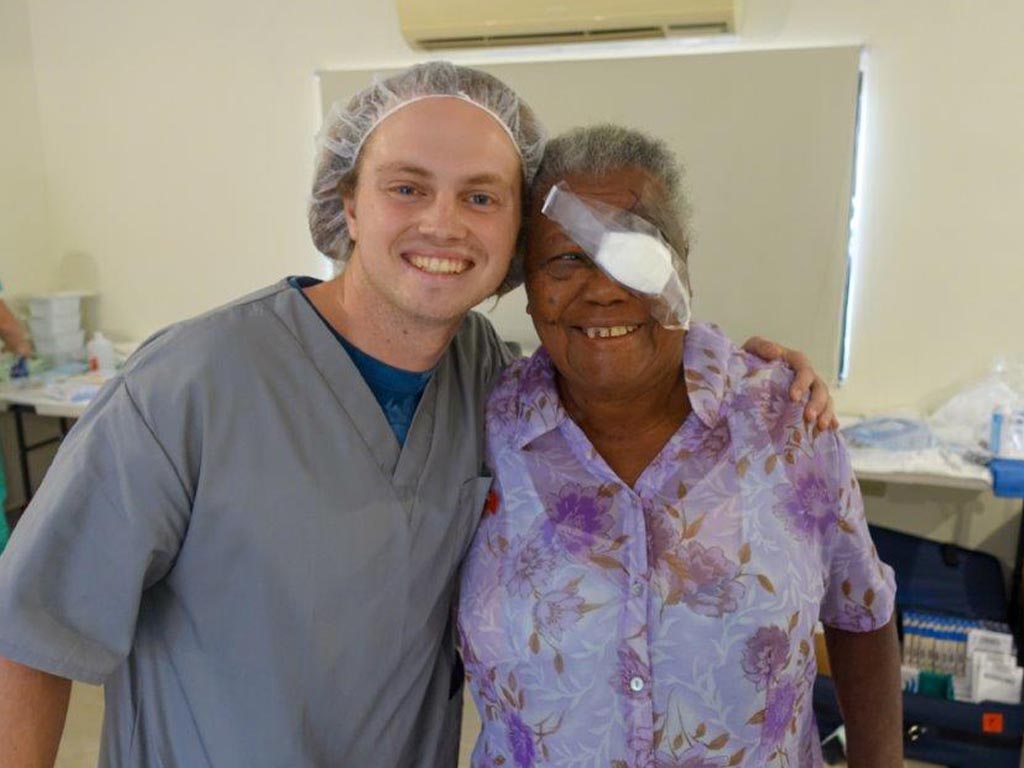Strabismus
Since 1974, SEE has worked diligently around the world to reduce the number of people impacted by strabismus. Our network of volunteer surgeons provide free treatment to thousands of patients every year, as well as skill-sharing and training on appropriate surgical techniques to help strengthen local health care infrastructure worldwide.
What is Strabismus?
Strabismus, or “crossed eyes”, is a condition in which both eyes do not look at the same place at the same time. It usually occurs in people who have poor eye muscle control or are very farsighted.
Six muscles attach to the eye to control how it moves. The muscles receive signals from the brain that direct their movements. Normally, the eyes work together so they both point at the same place. When problems develop with eye movement control, an eye may turn in, out, up, or down. The eye turning may occur all the time or may appear only when the person is tired, ill, or has done a lot of reading or close work. In some cases, the same eye may turn in each time. In other cases, the eyes may alternate turning.
Proper eye alignment is important to avoid seeing double, for good depth perception, and to prevent the development of poor vision in the turned eye. When the eyes are misaligned, the brain receives two different images. At first, this may create double vision and confusion. But over time the brain will learn to ignore the image from the turned eye. Untreated, eye turning can lead to permanently reduced vision in one eye. This condition is called amblyopia or “lazy eye”.
(Source: American Optometric Association, 2022)
Strabismus Classifications
Strabismus is a visual disorder in which the eyes are misaligned and point in different directions. It is a common condition among children affecting about 4% of all children in the United States. It can also occur later in life.
When the eyes are misaligned, typically one eye fixates on an object while the other eye turns in (esotropia), out (exotropia), up (hypertropia), or down (hypotropia). When this occurs, two different images are sent to the brain, confusing it, and further resulting in the brain rejecting the image from the weaker eye. Therefore, abnormal eye alignment blocks normal vision development in children, inhibiting their ability to perform in school and necessary day-to-day activities.
Strabismus is classified by the direction the eye turns:
- Esotropia: inward turning
- Exotropia: outward turning
- Hypertropia: upward turning
- Hypotropia: downward turning
Other classifications of strabismus include:
- The frequency with which it occurs (either constant or intermittent)
- Whether it always involves the same eye (unilateral)
- If the turning eye is sometimes the right eye and other times the left eye (alternating)
(Source: American Optometric Association, 2022)


154 million people impacted
It is estimated that roughly 154 million people around the globe currently have strabismus, with different variants of strabismus representing different percentages of those 154 million.
(Source: Tegegne, Fekadu and Assem, 2021)
Your donation will save someone’s sight
Risk Factors
Strabismus can be caused by problems with the eye muscles, the nerves that transmit information to the muscles, or the control center in the brain that directs eye movements. It can also develop due to other general health conditions or eye injuries.
Risk factors for developing strabismus include:
- Family history. People with parents or siblings who have strabismus are more likely to develop it.
- Refractive error. People who have a significant amount of uncorrected farsightedness (hyperopia) may develop strabismus because of the additional eye focusing they must do to keep objects clear.
- Medical conditions. People with conditions such as Down Syndrome and cerebral palsy or who have suffered a stroke or head injury are at a higher risk for developing strabismus.
(Source: American Optometric Association, 2022)
Experts don’t completely understand the cause of strabismus, but it results from eye muscles failing to work together. Idiopathic (resulting from an unknown cause) strabismus is the most common type. Other conditions can also cause it, including thyroid eye disease, nerve damage, and brain injuries. Risk factors include family history of strabismus, prematurity or low birth weight, retinopathy of prematurity, as well as conditions that affect vision, such as cataracts, severe ptosis and corneal scars.
Prevention
Strabismus cannot be prevented.
However, early diagnosis and proper treatment is essential to preventing vision loss resulting from amblyopia, also called “lazy eye”, and other complications stemming from strabismus.
Children should be monitored closely during infancy and the preschool years to detect potential eye problems, especially if there is family history with strabismus. Regular screening for young children includes testing for strabismus using light reflex for infants and cover testing for preschool-aged children.


Treating Strabismus
Treatment for strabismus may include eyeglasses, prisms, vision therapy, or eye muscle surgery. If detected and treated early, strabismus can often be corrected with excellent results. People with strabismus have several treatment options to improve eye alignment and coordination. They include:
- Eyeglasses or contact lenses. This may be the only treatment needed for some patients.
- Prism lenses. These special lenses are thicker on one side than the other. The prisms alter the light entering the eye and reduce how much turning the eye must do to view objects. Sometimes the prisms can eliminate the eye turning.
- Vision therapy. Your optometrist might prescribe a structured program of vision activities to improve eye coordination and eye focusing. Vision therapy trains the eyes and brain to work together more effectively. These eye exercises can help problems with eye movement, eye focusing and eye teaming and reinforce the eye-brain connection. Treatment can occur in your optometrist’s office as well as at home.
- Eye muscle surgery. Surgery can change the length or position of the muscles around the eyes so they appear straight. Often, people who have eye muscle surgery will also need vision therapy to improve eye coordination and to keep the eyes from becoming misaligned again.
(Source: American Optometric Association, 2022)
Treatment can preserve vision, straighten the eyes, and restore binocular (two-eyed) vision.
After a complete eye examination, an ophthalmologist can recommend the appropriate treatment. In some cases, eyeglasses are prescribed. Other treatments may involve surgery to correct the unbalanced eye muscles, or the removal of a cataract. Covering or patching the strong eye is often necessary.
Beyond vision impairment, this condition has lifetime consequences. Many individuals become societal outcasts and have difficulty getting married or finding a job. So even when vision may not be improved, surgery can improve an individual’s chance at a normal life.
SEE International & Strabismus
Ophthalmologists are rare in the developing world, and many countries are in desperate need of trained eye surgeons.
SEE is working diligently to reduce the number affected by this condition around the world by:
- Performing corrective surgeries
- Connecting patients with local doctors
- Training local eye care personnel in ophthalmology and surgical techniques
- Strengthening local health care infrastructure
Conditions We Treat
Get Our Email Updates
Connect With SEE
Learn More
Donate
(805) 380-7522
Mail donations to:
SEE International
PO Box 981263
W. Sacramento, CA 95798-1263
Home office address:
6500 Hollister, Suite 120
Goleta, CA 93117
Tax ID: #31-1682275



